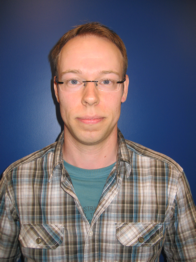High harmonic generation and ion acceleration with high-intensity laser pulses.
Promotion date: 18. September 2009
Promotor: Prof. Dr. Klaus -J. Boller
| Research is performed on high harmonic generation and ion acceleration, processes based on the interaction of gaseous and solid media with high-intensity laser pulses. Using gaseous media, an enhancement of high harmonic generation by harmonic excitation is demonstrated, for the first time, in a guided-wave geometry. Using extremely thin foils (freestanding nanofoils), the experimentally unexplored ‘transparent regime’ is entered, of laser-solid interactions. Theoretical predictions of enhanced maximum energy and numbers of accelerated ions, were disproved, because of the early expansion of the plasma before the drive pulse reaches its peak intensity. Via experiments and numerical modelling, improvements are formulated, using nanofoils with a higher damage threshold, and further improved pulse contrast at the picoseconds time scale. |
What was your initial challenge in this thesis project?
We were looking for new applications, using our special high-performance laser, constructed for laser wakefield acceleration. It took approximately one year to develop enough expertise in this area of research, reading and carrying out experiments to verify the interaction processes between the laser and gaseous media. We decided to combine extremes: targeting nanofoils with these laser pulses of highest intensities. High harmonics were generated. For example very short pulse lengths resulted, lasting only 10-18 seconds (attoseconds). Perhaps in the future these kinds of pulses can be of use to test recent electrodynamics theory.
Can the high performance laser be of special use in the future?
For electron and proton beams with energies reaching 10 - 100 MeV, whereas otherwise large-scale synchrotrons are needed. Before being of use for cancer therapy and diagnostics, the energies must be higher, and the number of ions as well.
Using extremely thin foils seemed attractive, but the experimental and numerical modelling showed that the foils expand too quickly, even when using state-of-the-art lasers. Perhaps using diamond-like carbon can be of use to produce better foils. The experiments involved, I carried out at the Physique à Haute Intensité group in France.
Was there a special moment during the project that was of special importance to you?
We targeted foils that are not visible because the foils possess a thickness of only one or two nanometers, which are the thinnest foils ever used for such experiments. This is called the transparent regime. Only by targeting the foils and measure the results, one could confirm a foil was actually present at the time.
Was the research a typically Mesa+ kind of project?
Mainly it was a project of the Laser Physics and Nonlinear Optics group and Physique à Haute Intensité group. A lot of expertise was needed to obtain smooth-surfaced nanofoils. With the help of NCLR, the dutch centre of laser research, another laser was used to drill tiny holes in the range of 200 micrometers in a frame, to support freestanding nanofoils.
For the laser group it is quite difficult to direct research towards nanotechnology. Perhaps this research can be a challenge to produce the proper nanofoils needed to generate high energy ions.
Another relationship to Mesa+ could be to develop the source of high harmonic generation to deliver radiation with short wavelengths, suitable for diagnostics of nanometer structures manufactured at Mesa+.
What are your future plans?
Next February I am starting a post-doc project at the FOM-institute of Plasmaphysics Rijnhuizen. Thin multi-layers of nanometer thickness are used in XUV-mirrors, to reflect e.g. 13 nm light rays. Experiments to focus these rays will be carried out at special facilities in, for example, Hamburg (DESY) and California (SLAC). It involves a free project in this interesting and actual field of research.
Eventually I would like to work in a big R&D company, for example Philips Natlab.

